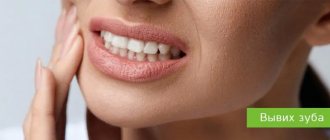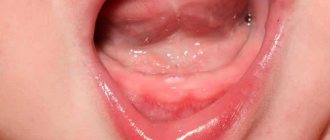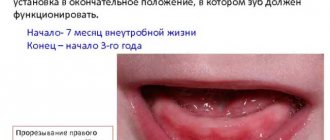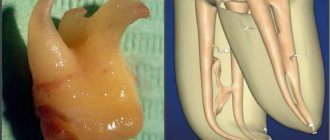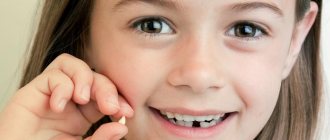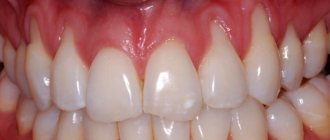Causes of dental injuries
Damage to baby teeth can be caused by any strong force applied to the jaw. For example, if a child was running and accidentally fell with his cheek on some object (chair, curb, step), this may well lead to a bruise or fracture of a tooth. Acute injuries also occur from blows to the face when children fight or play sports like boxing and karate.
Based on the nature of the acquisition, the reasons are divided into household, sports and travel. They are sudden and very painful. There are also chronic injuries that occur due to long-term bad habits. Biting nails, felt-tip pens, ballpoint pens, threads while sewing, or cutlery thins the enamel. Thin, fragile enamel and caries of baby teeth become the main factors of toothache in a child.
Symptoms
A strong blow to a tooth is accompanied by damage to periodontal tissue, and some fibers and small blood vessels rupture. There are no visible structural damage to the tooth; upon visual inspection, it appears intact. After a bruise, the tooth remains motionless, and minor mobility is rarely observed. The gums in the area of the injured tooth swell.
In the first hours after the impact, patients experience pain in the tooth, which intensifies when biting; the pain is aching in nature. The tooth feels high, and slight bleeding may occur from under the gum near it. When a bruise occurs, the neurovascular bundle of the tooth can be damaged, that is, the pulp is injured, and hemorrhage occurs in the pulp chamber, and the enamel becomes pink in color. A severe bruise can lead to the death of the pulp.
Often, when a bruise occurs, cracks appear on the tooth enamel, which can only be detected with a special examination.
In dentistry, the following types are distinguished:
- Bruised tooth. It can be considered the mildest type of injury, which is provoked by blows, attempts to bite through a hard object or “taste” it, which is especially typical for children 1-3 years old.
- Tooth dislocation. Such an injury means that the tooth has moved from its usual place. Typically, this type of injury requires significant force, so it does not occur as often as bruises. There are cases of complete dislocation, when the entire tooth falls out of the socket. Modern pediatric dentistry can save even a lost tooth if there are favorable conditions for this, and parents brought their child in immediately after receiving an injury.
- Tooth fracture. Fractures are immediately visible - these are visible chippings of a corner, piece or most of a baby tooth. Most children break their front teeth; the most popular causes of such damage include fights.
- Fracture of the root or crown of a tooth. They are considered rarer species, because in normal everyday life and sports conditions it is extremely difficult to get such a deep fracture. Regardless of whether the child has acquired a simple tooth bruise or suffered a fracture, in any case it must be shown to a specialist so as not to endanger the health of the young body.
Dental injuries in children
1
Stay calm and calm the baby.
2
2. Examine the child for symptoms associated with a concussion (nausea, headache, bruises).
3
3. Try to find the knocked out tooth or its fragments.
4
4. Rinse the tooth with mineral water (still) and place it in a physiological solution of sodium chloride 0.9% (if you can immediately purchase it at the pharmacy), in milk or in still water.
5
5. Try to come to the dentist within 2 hours so that the doctors can carry out a series of manipulations and splint (strengthen) the tooth.
6
6. If it is not possible to go to the dentist on the same day, you must place the tooth in a 0.9% sodium chloride solution or milk and leave it in the refrigerator until you seek dental care (no more than 24 hours).
At the clinic, the dentist will sanitize the hole, clean it of blood clots and bone fragments. The tooth is depulped and then replanted (placed back into the socket). The next stage will be splinting for a period of 6-8 weeks. During this time, any mechanical impact on the replanted tooth should be excluded.
Incomplete tooth luxation
means that the tooth has changed its position (usually in the vestibulo-oral direction), but is still in the socket. In such cases, the tactics are as follows: under local anesthesia, the dentist fixes the tooth, subsequent splinting and canal treatment. If the correct position is not accepted after the acute phase, then it is possible to influence the dentition through a brace system.
Impacted dislocation
. Childhood trauma, in which, due to vertical traumatic impact, a deepening or so-called impaction of the tooth into the alveolus occurs with damage to periodontal tissue. The treatment tactics are identical to the previous case. An attempt should be made to return the permanent tooth to its place, splint it, and perform root canal treatment if necessary.
In the case of baby teeth, dentists often take a wait-and-see approach. Often the teeth return to their place on their own after some time. Replantation of any type of dislocation is impossible in cases where a significant amount of time has passed after the injury. Fixation of baby teeth is impossible to avoid damage to the rudiment and difficulty in its eruption. If for one reason or another it was not possible to save the tooth, implantation is performed after restoring the integrity of the bone tissue. In children, this manipulation is possible no earlier than 18 years of age.
Content:
- Classification of injuries 1.1. Bruise 1.2. Traumatic dystopia 1.3. Complete dislocation 1.4. Crown fracture 1.5. Root fracture 1.6. Combined lesions
Children actively explore the world around them and most often do not think about safety measures.
Hence the frequent injuries. Moreover, not only the arms, legs and forehead suffer, but also the teeth. Statistics show that about 30% of visits to a pediatric dentist are related to injuries to temporary units. Let's look at what types of injuries occur in children's baby teeth and how to treat them correctly.
Types of injuries
Dental injuries vary in severity and possible consequences for the body.
Injury
The hard tissues of the tooth, as well as its position in the arch, remain intact, but upon impact, the soft tissues and ligaments that hold the tooth in the socket are injured. Swelling of the gums may develop, and it will be painful for the child to bite into food. If the pulp is not damaged, the tooth will recover on its own within 3–4 weeks of a special “soft” diet.
Dislocation
A complete dislocation is considered if a child knocks out a baby or permanent tooth. In this case, the tooth leaves the socket, but it can be straightened and returned to its place. How successful the healing of a lost tooth will be depends on the preservation of the roots, the absence of inflammatory processes, the speed of replantation and compliance with subsequent recommendations of the dentist. More often, in the event of an impact, temporary teeth completely leave the jaw - they have small roots and movable ligaments. Parents have only a few hours to return the tooth to its place with minimal loss. If more time has passed, most likely the tooth will no longer take root. Dislocation can also be incomplete, when the ligamentous apparatus of the tooth is partially damaged and its position changes. In this case, swelling occurs and bleeding often occurs. Only a doctor can correctly set a dislocated tooth. Without proper attention from specialists, an injured tooth with damaged ligaments may forever remain in the unphysiological position it occupied after the impact. If a lot of time has passed since the injury, an orthodontist will help the luxated tooth. Special plates with a calculated directed pressure force, made individually, will help the tooth return to its original position even after many years.
With complete luxation, the tooth completely falls out of the socket. It is important to see a dentist as soon as possible, minutes count. I repeat: replantation can only be carried out on permanent teeth; this cannot be done on milk teeth! Replantation is contraindicated:
- with extensive carious destruction of the tooth crown,
- with severe periodontal disease,
- for general somatic diseases and reduced immunity.
Selyutina Yu. I., member of the international association of pediatric dentists IAPD, winner of the federal competition of pediatric dentists of Russia, pediatric dentist, writer, blogger, founder of the author's Center for Dentistry[3]
Crack
With a minor impact, damage can only affect the enamel - it can chip or break. Cracks can be so insignificant that they are not even detectable during visual inspection. It is necessary to use special optical devices or a fiber-optic LED for transillumination examination. There is no special treatment for cracks.
Fracture
There are cases when a child has partially knocked out a permanent tooth. If part of the tooth remains in the tissues, and part is lost, this is a fracture. It can be transverse, oblique, longitudinal or splintered. Depending on the trajectory of the impact or fall, both the crowns of the teeth and their roots are susceptible to fractures. Most often, in 67.8% of cases, crowns break when permanent teeth are injured. The prognosis of treatment will depend on the location of the damage and whether the tooth cavity has been opened [1, 4].
Trauma to a child’s front tooth – what should be done?
The mobility of children and their carelessness leads to the fact that a child, if he hits, can damage his tooth. In this case, it should definitely be shown to a pediatric dentist. Depending on the nature of the injury, the specialist will determine whether tooth extraction will be necessary in dental surgery, or whether it is possible to save the damaged tooth. Although the removal of a baby tooth is not perceived as a tragedy by many parents, its early absence can negatively affect the position and condition of permanent teeth.
In order to find out the nature of the damage, clinical studies are carried out, as well as a number of additional ones. Conducting a clinical examination, the doctor determines the level of tooth fracture, finds out how much it is displaced, how damaged the surrounding tissues are, whether there is a violation of occlusion or staining of the tooth, etc.
Instrumental methods that make it possible to clarify the nature of the injury include: electroodontometric measurements, transillumination method, and dental radiography.
Palpation allows you to determine whether the tooth or any part of it is mobile. Is there swelling or bulging that occurs when the alveolar process is broken or the tooth itself is displaced. Mobility of an injured tooth has three degrees.
First degree: mobility usually does not require splinting.
Second degree: mobility often requires securing (stabilizing) the injured tooth with splints.
Third degree: tooth mobility indicates the need for urgent splinting, and sometimes tooth replantation.
In all three cases, treatment is performed under freezing anesthesia.
If only one tooth is broken, it is necessary to percussion all teeth located nearby, as they can also be injured. Vertical percussion reveals the degree of damage to the periapical tissues, while horizontal percussion diagnoses pulpal edema, or hemorrhage into the pulp, and should be performed with extreme caution.
And no matter how trivial a tooth injury may seem, an x-ray must be taken. An x-ray provides all the information the doctor needs about the condition of the injured tooth. It allows us to identify the direction of the dislocation, how well the equine system is formed, whether there is an impaction of the tooth, and whether periapical changes have occurred. Using an X-ray of the tooth, the doctor sees the condition of the entire periodontium, the width of the pulp chamber, the growth zone, and determines whether there are foreign bodies.
A timely x-ray, its correct analysis, successful and painless treatment will allow your child to save his tooth. And prevention and deep fluoridation of teeth will make them healthy and resistant to caries.
What types of injuries are there?
Childhood tooth trauma can occur as a result of a blow, fall or accident (it is called acute) or under the influence of dental pathologies and bad habits. There are several classes:
- Bruises of teeth with minor damage (cracks in enamel).
- Simple fractures of the crown part of the tooth.
- Complicated fractures of the coronal part.
- Complete fracture of the dental crown.
- Longitudinal crown-root fracture.
- Tooth root fracture.
- Tooth subluxation.
- Tooth dislocation.
Parents should know that if a tooth or jaw is injured, they should immediately contact a dentist or maxillofacial surgeon. The specialist will stop the bleeding, provide first aid and order an x-ray to determine the extent of damage to tissues, teeth, tooth buds, etc. A correct diagnosis will help provide quick and effective treatment.
